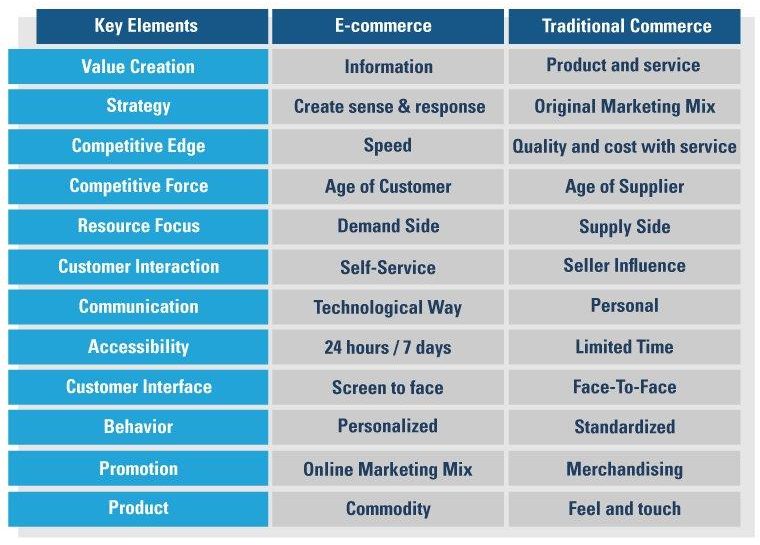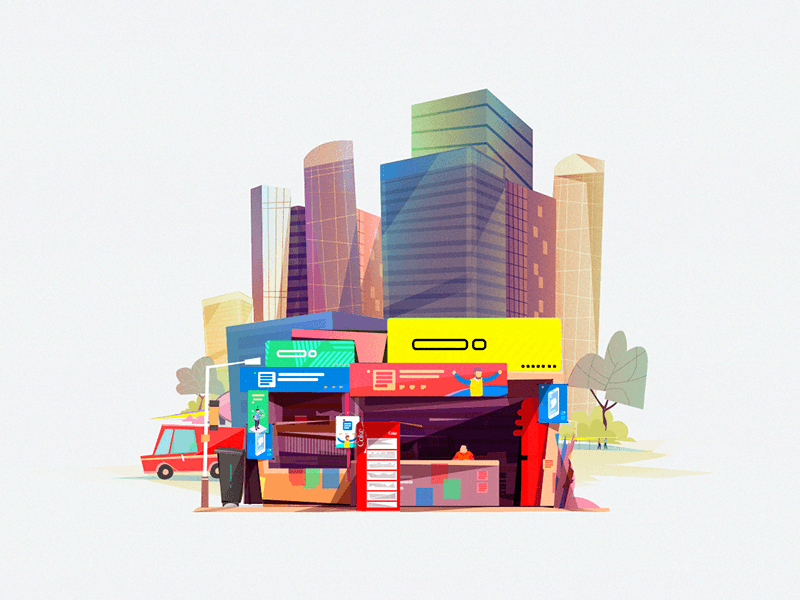To best understand the different challenges and benefits concerning opening your e-commerce, you have to understand how it differs from traditional brick-and-mortar stores. Previously, we have addressed the four drivers of e-commerce in our range of articles. On the basis of this, we have developed an understanding of which areas have an impact on all online activities.
Depending on the area, an innovative corporate culture, customer knowledge, data strategy or digital transformation can have the greatest impact on success in e-commerce.
In this article, we will look at a comparison between e-commerce and traditional commerce. A comparison is important to analyse what concerns a company and where the differences are. In order to handle the differences, companies have the option of creating action plans to develop the e-commerce area in an optimal manner.
Today, many companies are required to be present online and to process at least certain transactions digitally. This can affect both the sourcing department and the sales department. The pressure of digital transformation is very high, so many companies act without a strategy or any tactics, resulting in many areas being optimised in an unclear manner or only partially optimised. This includes the IT strategy, employee knowledge, e-commerce readiness, and security and certifications.
Let us take the different elements and requirements of a hotel website by way of an example. Here we see a number of basic elements that are required to operate this site successfully:
- Images, videos and descriptions of the hotel and amenities, location, services etc.
- Visitor reviews
- Display showing room availability and prices for the selected period
- The opportunity to make reservations online and guarantee them with a payment.
These are just a few of the simplest examples of what a customer would expect from a hotel website. If the expectations are not met, the user will turn to the competition. There is also the risk of websites being offline, payments or bookings not being possible for technical reasons or hackers paralysing the site. Poor reviews could also be submitted online, or private details leaked.
Natural E-Commerce Conversion Advantages: Where E-Commerce Shines
To digitise a business successfully, comparing traditional commerce with e-commerce and showing what needs to be optimised is relevant. The following graphic shows a comparison, on the basis of which an action plan should be developed. The following main points can be brought together by way of a comparison:
Value Creation: Face-to-Face vs Display Information
Online, the customer uses all possible channels to obtain information, whereas traditionally it is the product and the service that are the focus.
In a shop, employees are better able to explain the value, something that is particularly important for complicated products. Digitally, added value can be explained through service channels such as chat or telephone consultation.
This comparaison shows the importance of your marketing strategy, and why it should be clear enough for your customers to understand all the benefits of your product without someone to explain it to them.
Strategy: Traditional vs. Digital
How do I talk to the customer and make him or her aware of products and services? In physical shops the classical marketing mix can be used.
Digitally, however, the channels are much more diverse and are also affected by offline marketing. Especially with the rise of omni-channel customers, an e-commerce has to be everywhere all the time.
The marketing strategy must therefore be made up of a combination of both worlds.
Communication: Omnichannel vs Focused
In e-commerce, this takes place through the most varied of technologies.
Traditionally, personal communication is possible and preferred; online this can only be substituted by software, e.g. chat functions.
However, these functions help create a personalized brand experience through your site and can push conversion in ways that a traditional brick-and-mortar store cannot.
Customer interaction: Passive vs Active
Online, the focus is on self-service so the customer can inform themselves. Among other things, customers expect a user experience, speed and clarity.
Buyers go online specifically for having a larger range of choice and because they feel that shopping online should be easier than shopping in a physical store.
You should make absolutely sure that they’re not wrong about it being easier when visiting your e-commerce.
Accessibility: Time vs Communication
The customer expects online shopping experiences and information 24/7 and everywhere. Easy access tailored to the respective end device is also important.
In physical shops, however, the customer is only offered limited information and purchasing options, as well as a further limitation of stock.
This should be something that is optimised for e-commerce stores, as if you have an advantage over brick-and-mortar stores, you should exploit it as much as possible.
Product: Accessibility vs. Look & Feel

Products can be advertised through information and images or videos online, but only in physical shops can these goods also be tried on and felt.
It is therefore important to position digital products in such a manner that the customer feels sufficiently well informed. Another great tip is to make your returns and exchanges policy clear and easy to use.
This will foster confidence in your buyer and reassure them that they can try the product and send it back if it doesn’t correspond to their needs.
A more in-depth analysis should be carried out to identify which areas show significant discrepancy so an action plan can be developed. The field of e-commerce shows major challenges which affect customer behaviour in particular. It’s important to understand in what areas your e-commerce is at a disadvantage in regards to traditional physical stores, and where your online store outshines physical ones to appropriately take advantage of these aspects.
Dynamic offers and advertising, personalised content and above all simple user navigation are the basic building blocks for success. This often means the development of new strategies, IT tools and above all customer-centred thinking. In the age of the customer the focus is on personalised solutions and information, a rapid service and the provision of relevant information. The key to success lies in knowledge about the customer and long-term customer retention. The basis of this is using the right processes to collect the necessary data.
Image credit : Rezaul Razib





